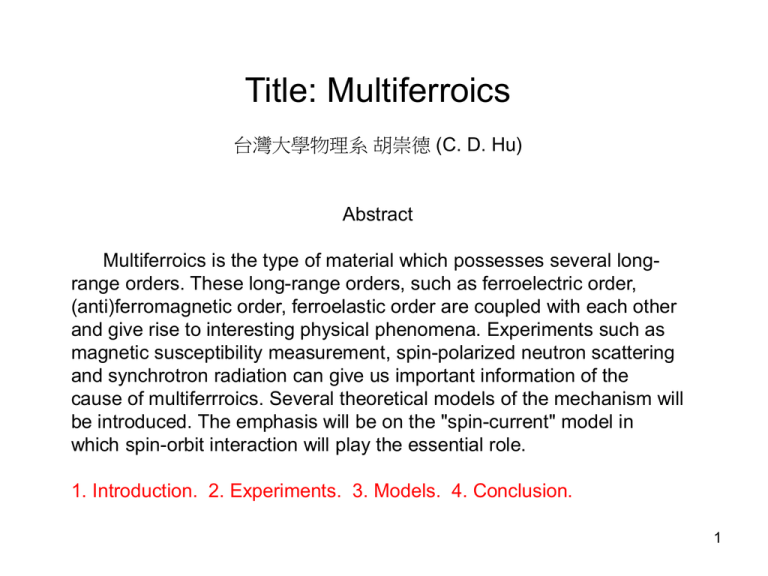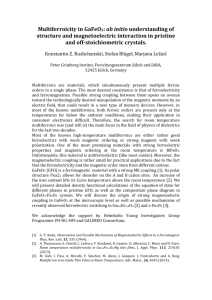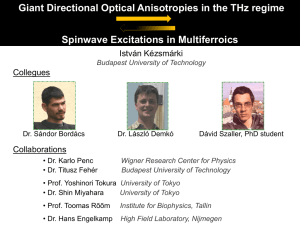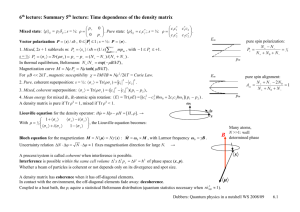投影片 1
advertisement

Title: Multiferroics 台灣大學物理系 胡崇德 (C. D. Hu) Abstract Multiferroics is the type of material which possesses several longrange orders. These long-range orders, such as ferroelectric order, (anti)ferromagnetic order, ferroelastic order are coupled with each other and give rise to interesting physical phenomena. Experiments such as magnetic susceptibility measurement, spin-polarized neutron scattering and synchrotron radiation can give us important information of the cause of multiferrroics. Several theoretical models of the mechanism will be introduced. The emphasis will be on the "spin-current" model in which spin-orbit interaction will play the essential role. 1. Introduction. 2. Experiments. 3. Models. 4. Conclusion. 1 1. Introduction Multiferroics: The kind of material which have several long-range orders such as antiferromagnetism and ferroelectricity. http://physics.aps.org/ articles/v2/20 Physics 2, 20 (2009) Daniel Khomskii Illustration: Alan Stonebraker 2 Ferroelectricity: Material which has net electric polarization. BiFeO3 BaTiO3 movement of Ti(4+) lone-pair of 6s-electrons of Bi(3+) YMnO3 TbMn2O5 tilting of MnO5 dimerization 3 Antiferromagnetism: Material which has no net magnetization but has long-range magnetic order. Sinusoidal Cycloidal spiral Proper screw 4 There are more than 100 multiferroic compounds. Type I multiferroics High Tc and large electric polarization, but weak coupling between electricity and magnetism. Type II multiferroics Low Tc and small electric polarization, but strong coupling between electricity and magnetism. 5 K.F. Wan, J.-M. Liu and Z.F. Ren, Advances in Physics 58, 321–448 (2009) 6 7 8 2. Experiments RMnO3 orthorhombic c b a O: Oxygen R: Rare earth elements Mn: Manganese 9 Kimura et. al. PRB 71 224425 (2005), TN=41K, Tlock=28K. 10 Kenzelmann et. al. PRL 95, 087206 (2005) neutron scattering 11 12 3. Models Why are electric polarization and magnetic order coupled? D B 0 Maxwell's equations E B t H j D t 13 A. Atomic displacement (lattice distortion) Ca3CoMnO6 Choi et. al., PRL 100, 047601 (2008) face-sharing octahedra along c-axis 14 H J 1 i S i S i 1 J 2 i S i S i 2 , 4+ 2+ Mn Co 4+ 2+ 4+ 2+ J 1 0, 4+ J2 0 2+ 4+ 15 B. Spin current model z TM1 H. Katsura, N. Nagaosa and A. V. Balatsky, PRL 95, 057205 O TM2 S1 y S2 x eg p V eg 16 d-orbitals under crystal field of cubic symmetry 17 H p p x , p x , d d x 2 y 2 , d x 2 y 2 , U s j S j V ( p x , d x 2 y 2 , H .c .) hybridization Hund’s coupling Sj: local spin Direction: S j (sin j , 0, cos j ), j q R j sj: mobile spin U s j S j S j an d s j are p arallel. 18 a L L ,d , x 2 y 2 a p p,x cos( L / 2) sin( L / 2) cos( R / 2) a R R ,d , x 2 y 2 a p p , x sin( R / 2) spin-orbit interaction l s zx l s sin( / 2) cos( / 2) 19 3 V 1 P e r eI eˆ S 1 S 2 2 12 S I d , zx ( r ) z p , x ( r ) d r 3 eˆ12 || bond direction * electronic origin P 20 z Result y x spiral spin P eˆ z 21 spin current H J S i S j j s S j i[ S j , H ] J S j S j 1 S j 1 S j spin current electric field electric polarization AC (Aharonov-Casher) effect E E charge accumulation 22 Spiral Spin and Orbital Ordering The spin current model gives a very small electric polarization. It is due to cancellation of the contribution of entire energy band. j e i / 2 cos( q R j / 2) [ A B cos( Q R j )] ( r R j ) d1 e i / 2 sin( q R / 2) B sin( Q R ) ( r R ) j j j d 2 q is the w ave vector of spiral spins. Q is the w ave vector of O O . 23 P 2 eIV a 0 ( d p ) Q s j s j 1 3 V 1 P eI eˆ S 1 S 2 2 12 S 24 Conclusion 1. Multiferroics is a field of rich physics. 2. Multiferroics is a field driven by experiments. 3. The theoretical models are not complete. 4. Multiferroics is related to a lot other physical phenomena such as, lattice distortion, charge order, orbital order, spintronics, and magnetic properties. 25 Polarization and Dzyaloshinskii-Moriya interaction I. Dzyaloshinskii, J. Phys. Chem. Solids 4, 241 (1958). Tôru Moriya, Phys. Rev. 120, 91 (1960) exchange interaction with spin-orbit coupling E SO SO V V D(/E) (t2/U), D/JSEg/g 26 ( l S i ) 0 m ( JS i S j ) m 0 ( JS i S j ) 0 m ( l S i ) m 0 E m E0 Em E0 Em m H DM ( l ) 0 m ( J [ S i , S i S j ]) m 0 E0 Em D ij S i S j m D ( l ) 0 m ( iJS i S i ) m 0 iJ E E0 Em l ,J 0m V 4 dp 3 27 Relation between multiferroics and DM H V V ( 1) [cos j d j c pj , l , e sin d j c pj , l , ] H .c . P r l ,m ,n i l pm H V d n ( d p ) E cf dn l dl n s l d l r pm Im n s l ( s j s j 1 ) i p m H V ,i d n Pk 2 e l ,m ,n H DM D ij S i S j Pk 2 e l ,m ,n 2e ( d p ) E cf ( d p ) E cf M H DM 0 E0 EM iJ i p m H V ,i d n d n l j d l ( s N s N 1 ) j d l rk p m E cf li Si S j d n l j d l ( s N s N 1 ) j d l rk p m 0 l rk M 28 H DM DM interaction j Spin current J i aV 4i aV 2 Gauge field i Aj AC effect H DM D ij S i S j iJ E cf li Si S j ( d N 1 d N d N d N 1 ) e B |i i: bond direction j j ( s N 1 s N ) | j e B |i 2 iJ eaV E cf i A j ji 8 Jm c l j e B |i * 2 4m c ijk E k j * 2 E eV a E cf eB l 29 z y x Eeff,z s Mn jxy O Mn 30










